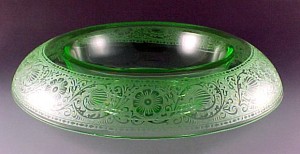Then I found some sturdy, handsome (I think) brown glassware at Goodwill (99 cents per stem!). Things began to fall in place, and the table below is the result.
 I used clear glass single candleholders and pressed glass tealight holders. I can't give up sparkle entirely, and I didn't want the silverplated flatware to be the only shiny thing on the table. The taper candles are by Colonial Candles. Where else do you turn when you need to match the color of the sliced cantaloupe on your dinnerware?
I used clear glass single candleholders and pressed glass tealight holders. I can't give up sparkle entirely, and I didn't want the silverplated flatware to be the only shiny thing on the table. The taper candles are by Colonial Candles. Where else do you turn when you need to match the color of the sliced cantaloupe on your dinnerware?

The “Tampico” pattern was part of the “Futura” line of dinnerware introduced by the Red Wing company in the mid-1950s. The pattern was designed by Charles Murphy and won top prize at the National China, Pottery and Glass show in 1956.
The original advertising blurb for Tampico [as shown in Ray Reiss’ identification guide to Red Wing Dinnerware] says it creates a fiesta-like atmosphere and is perfect “whether you’re serving burgers backyard style or snacking on TV trays. A great conversation starter for today’s garden party!"
The Futura Tampico pattern was also advertised as the “new south of the border look” in dinnerware. Like all Red Wing dinnerware, Tampico is oven proof, hand painted, and sealed by the glaze to keep each piece color fast.

Red Wing Pottery had its origins in the rich clay found in Red Wing, Minnesota, in the early 1860's. The company would make its official debut in 1877 as the Red Wing Stoneware Company. Over the next 90 years, the company would have six incarnations with the last being named Red Wing Potteries.
The flatware is "Leilani" by 1847 Rogers Brothers. The pattern was produced from 1961-68.

A brochure states that "It's fiesta time every time you dine on this exciting new Red Wing dinnerware, hand-painted in rich browns, greens and vivacious melon accents, lightly flecked with brown overall. Tampico - a pattern to pep up the 3-times-a-day routine - to make all your entertaining colorful and different." It goes on to say that Tampico pattern dinnerware is "the life of the party! If dinnerware could dance, Tampico would surely outstep them all! Set your table with this vivacious dinnerware, and suddenly it's a party!"
The stemware is "Arlington" (circa 1978) by Viking Glass. What began in 1900 as New Martinsville Glass Manufacturing Company became The Viking Glass Company in 1944. Located in New Martinsville, West Virginia, these two companies were producers of elegant and colorful decorative glass pieces. The company went out of business in 1999. Due to the popularity of their glassware and high sales volumes, much of Viking's output remains available today in stores that sell vintage and antique items (at reasonable prices).

Red Wing Potteries introduced their Futura line of dinnerware in 1955 with excitingly modern shapes. Designed by Charles Murphy, the flatware pieces in the line are slightly ovoid rather than round, and the serving pieces are slightly off-center. A Red Wing brochure states of the Futura line that "Red Wing's new shape is modified oval, designed for practicality as well as interest and grace. Plates, bowls and cups are easy to handle, easy to stack, and require minimum table space - ideal for outdoor and buffet service."

With fruit and wine bottles in the dinnerware's motif, I thought clusters of grapes might be enough to provide an appropriate centerpiece. Then, I thought I'd insert a few Black-eyed Susans from the garden for additional color. On closer examination, the blooms weren't "centerpiece ready." I found a mixed bouquet at Kroger reduced from $15 to $2.99. Voilà!

I poured water in the vegetable bowl before adding the grapes and used the fruit to hold the flower and greenery stems in place. I cut the stems at an angle and inserted them carefully to avoid piercing the skins of the grapes.

My favorite time of day for photography is late afternoon, when shadows create interesting effects.





And then, of course, it's time to light candles ....









Charles Murphy
(1909 - 1994)
Born in Ohio, the Pottery Mecca of the United States, Charles Murphy was destined for a career in ceramics. When Charles was a child, his father was employed by Saxon Potteries, who also gave the young lad his first job during summers when he was away from school. Young Charles went on to study fine art at the Cleveland Art Institute, working in his spare time at Guy Cowan's pottery studio. His talent gained him a scholarship to study art in Europe, but after his return to the United States during the throes of the Great Depression Murphy was forced to re-enter the field of pottery. During this time he worked alongside such greats in the field as Frederick Rhead of the Homer Laughlin Company. In 1940, Murphy began work for Red Wing Potteries where he remained until the late 1950's, with the exception of a short stint in the military. Later in life, Murphy returned to the fine arts working primarily as a wildlife painter.

Red Wing Dinnerware lines had glazes applied by hand via an assembly line structure. In the photo below, women using artists' brushes applied individual strokes to light stencil markings on a piece of dinnerware. The piece was then sent down the line to the next decorator who would apply a different stroke. The more strokes a pattern had the higher Red Wing’s production costs.
Tampico was Red Wing's most complicated pattern. It required more brush strokes (150+) than any other.

A selection of relevant promotional materials from the past:






Tampico is a city in the Mexican state of Tamaulipas.
Popular culture:
Joseph Hergesheimer's 1920s novel Tampico tells a tale of expatriates living in the city.
"Tampico" is the title of a 1945 song composed by US artist Gene Roland and produced by jazz musician and conductor Stan Kenton, with lead vocals by June Christy. Roland suggested in his song that the city had become more American than America itself.
Director John Huston set the opening scenes of his motion picture epic, The Treasure of the Sierra Madre in Tampico.
Jimmy Buffett wrote the song "Tampico Trauma" about experiences in the city.
Episode 33 of the television series Maverick is set in the city and titled "Escape to Tampico."
The novel "Tampico's Gold" by Elizabeth Braun describes Tampico in poetic detail.
Tampico is a popular orange-flavored beverage based in the United States.
"Tampico" by Gene Roland and produced by Stan Kenton. The song gave June Christy a top-ten hit in 1945, peaking at #6 on the Billboard charts. Christy later commented to the Jazz Journal International that she had been disappointed that her first recording with Kenton was Tampico, but was fortunate that it was a hit and established her right away.
Guaranteed to have you humming along -- enjoy!
I hope you enjoyed your visit. Please stop by Susan's Between Naps on the Porch for the inspiring tables of Tablescape Thursday!













































